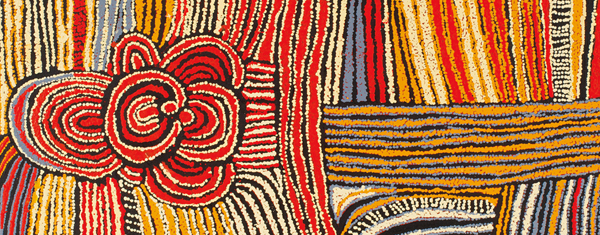
IMAGE: Walangkura Napanangka (Pintupi, born c.1945, Walungurru (Kintore), Western and Central Desert, Northern Territory) Lupul (detail), 2005. Acrylic on canvas, 122 x 122 cm. Gift of Will Owen and Harvey Wagner; 2009.92.321. © 2013 Artist Rights Society (ARS), New York/VISCOPY, Australia
The Toledo Museum of Art will introduce artworks from the other side of the globe to a new audience when Crossing Cultures: The Owen and Wagner Collection of Contemporary Aboriginal Australian Art at the Hood Museum of Art goes on view April 12–July 14, 2013.
“Although exhibitions of art by Indigenous Australians have been shown on both the East and West Coasts of the United States, the Toledo Museum of Art is pleased to introduce these extraordinary works for the first time to our regional audience,” said Director Brian Kennedy.
Kennedy, who wrote an essay for the exhibition catalog, became acquainted with Aboriginal artists while serving as director of the National Gallery of Australia in Canberra. He later met art collectors Will Owen and Harvey Wagner when he hosted an Aboriginal art exhibition in 2006 while director of the Hood Museum of Art at Dartmouth College.
Crossing Cultures explores more than 100 works of contemporary Indigenous art from Australia spanning five decades by artists from desert communities as well as major metropolitan centers. Owen and Wagner collected the objects and donated them to the Hood Museum of Art. Among artists represented are Michael Riley, Shorty Jangala Robertson, Danny Gibson Tjapaltjarri, Destiny Deacon and Walangkura Napanangka.
Curated by Stephen Gilchrist, curator of Indigenous Australian art at the Hood Museum of Art, the exhibition encompasses the broad range of media and materials employed by contemporary Aboriginal artists, from acrylic painting on canvas to earthen ochre painting on bark, as well as sculpture and photography, among other media.
“The diversity of artistic perspectives assembled in Crossing Cultures speaks to the richness of the contemporary Aboriginal art tradition, which has been called ‘the last great art movement of the 20th century,’” said Gilchrist. “The objects included in this exhibition reference and reinvigorate traditional iconographies, speak to the history and legacy of colonization, and meaningfully contribute to the growing international discourse on contemporary Indigenous art.”
Art historian Henry F. Skerritt, a contributor to the exhibition catalog, writes that Crossing Culturesoffers “a perfect illustration of why Australian Aboriginal art is at the vanguard of international contemporary art.” He notes in a recent blog posting that “better than any other single movement, Aboriginal art reveals the connective fibers that allow us to maintain and communicate our unique identities in a world of accelerating differences.”
While a number of influential artists who contributed to the development of an Indigenous art canon since the 1970s are in the exhibition, the focus is on subsequent generations of artists who are breathing new life into ancient stories and broadening the possibilities of Indigenous Australian art. There are contemporary paintings that summon aspects of “the Dreaming” as well as photographs from urban-based artists who depict the contemporary realities of Indigenous Australians.
For Indigenous Australian peoples the Dreaming refers to a time long ago when ancestral beings moved across the land creating life and the significant geographic features of the continent. Yet Aboriginal peoples do not conceive of the past, present and future in progression but, instead, as part of one whole story. The Dreaming, then, also means to “see and understand” today the laws and responsibilities established by these ancestors. Some Dreaming stories are communal; others are personal, but all of the Dreaming stories pass on knowledge, cultural values and belief systems to later generations.
Resonant with cultural memory, objects in the exhibition speak to both the history and the legacy of colonization in Australia. The Hood Museum of Art organized this traveling exhibition with the generous support of Kate and Yaz Krehbiel, Class of 1991, Thayer 1992, and Hugh J. Freund, Class of 1967.